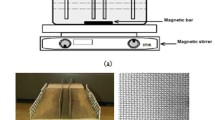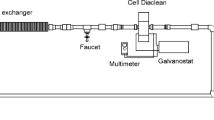Abstract
Ionic liquids (IL) have emerged as the next-generation “green” solvent that can replace traditional organic solvent due to properties such as high thermal stability and no vapour pressure. However, their increased usage inevitably allows them to find their way into the environment. The objective of this study was to evaluate the role of autotrophic ammonia-oxidising bacteria (AOB) in the potential removal of 1-dodecylpyridinium chloride ([DPy]+Cl) in both short- and long-term studies. In short-term batch experiments, it was observed that a notable amount of [DPy]+ can be removed by the AOB culture with the removal mechanism being biodegradation and absorption, with the latter playing a greater role. It was also found that [DPy]+ can be released back into the liquid phase when AOB’s preferred substrate, NH3, was present. In the long-term study, [DPy]+Cl was successfully biodegraded and a total of nine transformation products were identified. The biodegradation pathway was also proposed. This study demonstrated that [DPy]+Cl can be biological transformed by enriched AOB culture and the accumulation of the by-product did not show long-term negative impact on AOB activities.




Similar content being viewed by others
References
Abrusci C, Palomar J, Pablos JL, Rodriguez F, Catalina F (2011) Efficient biodegradation of common ionic liquids by Sphingomonas paucimobilis bacterium. Green Chem 13(3):709–717
APHA (2012) Standard methods for examination of water and wastewater. American Public Health Association, Washington DC
Arp DJ, Yeager CM, Hyman MR (2001) Molecular and cellular fundamentals of aerobic cometabolism of trichloroethylene. Biodegradation 12(2):81–103
Bedard C, Knowles R (1989) Physiology, biochemistry, and specific inhibitors of CH4, NH4 +, and co-oxidation by methanotrophs and nitrifiers. Microbiol Rev 53(1):68–84
Bouquillon S, Courant T, Dean D, Gathergood N, Morrissey S, Pegot B, Scammells PJ, Singer RD (2007) Biodegradable ionic liquids: selected synthetic applications. Aust J Chem 60(11):843–847
Cho CW, Pham TPT, Jeon YC, Vijayaraghavan K, Choe WS, Yun YS (2007) Toxicity of imidazolium salt with anion bromide to a phytoplankton Selenastrum capricornutum: effect of alkyl-chain length. Chemosphere 69(6):1003–1007
Cho CW, Pham TPT, Kim S, Song MH, Chung YJ, Yun YS (2016) Three degradation pathways of 1-octyl-3-methylimidazolium cation by activated sludge from wastewater treatment process. Water Res 90:294–300
Chubar N, Behrends T, Van Cappellen P (2008) Biosorption of metals (Cu2+, Zn2+) and anions (F−, H2PO4 −) by viable and autoclaved cells of the Gram-negative bacterium Shewanella putrefaciens. Colloid Surf B-Biointerfaces 65(1):126–133
Docherty KM, Aiello SW, Buehler BK, Jones SE, Szymczyna BR, Walker KA (2015) Ionic liquid biodegradability depends on specific wastewater microbial consortia. Chemosphere 136:160–166
Docherty KM, Dixon JK, Kulpa CF Jr (2007) Biodegradability of imidazolium and pyridinium ionic liquids by an activated sludge microbial community. Biodegradation 18(4):481–493
Docherty KM, Joyce MV, Kulacki KJ, Kulpa CF (2010) Microbial biodegradation and metabolite toxicity of three pyridinium-based cation ionic liquids. Green Chem 12(4):701–712
Docherty KM, Kulpa CF (2005) Toxicity and antimicrobial activity of imidazolium and pyridinium ionic liquids. Green Chem 7(4):185–189
Farooq A, Reinert L, Leveque JM, Papaiconomou N, Irfan N, Duclaux L (2012) Adsorption of ionic liquids onto activated carbons: effect of pH and temperature. Microporous Mesoporous Mater 158:55–63
Gathergood N, Garcia MT, Scammells PJ (2004) Biodegradable ionic liquids: part I. Concept, preliminary targets and evaluation. Green Chem 6(3):166–175
Guine V, Spadini L, Sarret G, Muris M, Delolme C, Gaudet JP, Martins JMF (2006) Zinc sorption to three gram-negative bacteria: combined titration, modeling, and EXAFS study. Environ Sci Technol 40(6):1806–1813
Hezave AZ, Dorostkar S, Ayatollahi S, Nabipour M, Hemmateenejad B (2013) Effect of different families (imidazolium and pyridinium) of ionic liquids-based surfactants on interfacial tension of water/crude oil system. Fluid Phase Equilib 360:139–145
Hough WL, Smiglak M, Rodriguez H, Swatloski RP, Spear SK, Daly DT, Pernak J, Grisel JE, Carliss RD, Soutullo MD, Davis JH Jr, Rogers RD (2007) The third evolution of ionic liquids: active pharmaceutical ingredients. New J Chem 31(8):1429–1436
Huang JJ, Kimura T (1973) Studies on adrenal steroid hydroxlases – oxidation-reduction properties of adrenal iron-sulfur protein (adrenodoxin). Biochemistry 12(3):406–409
Huang RTW, Peng KC, Shih HN, Lin GH, Chang TF, Hsu SJ, Hsu TST, Lin IJB (2011) Antimicrobial properties of ethoxyether-functionalized imidazolium salts. Soft Matter 7(18):8392–8400
Jing CQ, Mu LM, Ren TF, Li BN, Chen SJ, Nan WB (2014) Effect of 1-octyl-3-methylimidazolium chloride on cell replication and membrane permeability of Escherichia coli DH5 alpha. Bull Environ Contam Toxicol 93(1):60–63
Kassotaki E, Buttiglieri G, Ferrando-Climent L, Rodriguez-Roda I, Pijuan M (2016) Enhanced sulfamethoxazole degradation through ammonia oxidizing bacteria co-metabolism and fate of transformation products. Water Res 94:111–119
Kawano R, Matsui H, Matsuyama C, Sato A, Susan M, Tanabe N, Watanabe M (2004) High performance dye-sensitized solar cells using ionic liquids as their electrolytes. J Photochem Photobiol A Chem 164(1–3):87–92
Keskin S, Kayrak-Talay D, Akman U, Hortacsu O (2007) A review of ionic liquids towards supercritical fluid applications. J Supercrit Fluids 43(1):150–180
Kim JY, Ryu K, Kim EJ, Choe WS, Cha GC, Yoo IK (2007) Degradation of bisphenol A and nonylphenol by nitrifying activated sludge. Process Biochem 42(10):1470–1474
Lemus J, Palomar J, Gilarranz MA, Rodriguez JJ (2013) On the kinetics of ionic liquid adsorption onto activated carbons from aqueous solution. Ind Eng Chem Res 52(8):2969–2976
Li XH, Zhao JG, Li QH, Wang LF, Tsang SC (2007) Ultrasonic chemical oxidative degradations of 1,3-dialkylimidazolium ionic liquids and their mechanistic elucidations. Dalton Trans(19):1875–1880
Majewsky M, Wagner D, Delay M, Brase S, Yargeau V, Horn H (2014) Antibacterial activity of sulfamethoxazole transformation products (TPs): general relevance for sulfonamide TPs modified at the para position. Chem Res Toxicol 27(10):1821–1828
Mihelj T, Tomasic V (2014) Thermal behavior of dodecylpyridinium-based surfactant salts with varied anionic constituent. J Dispers Sci Technol 35(4):581–592
Munro AW, Lindsay JG (1996) Bacterial cytochromes P-450. Mol Microbiol 20(6):1115–1125
Neumann J, Grundmann O, Thoming J, Schulte M, Stolte S (2010) Anaerobic biodegradability of ionic liquid cations under denitrifying conditions. Green Chem 12(4):620–627
Neumann J, Steudte S, Cho C-W, Thoeming J, Stolte S (2014) Biodegradability of 27 pyrrolidinium, morpholinium, piperidinium, imidazolium and pyridinium ionic liquid cations under aerobic conditions. Green Chem 16(4):2174–2184
Osorio V, Sanchis J, Abad JL, Ginebreda A, Farre M, Perez S, Barcelo D (2016) Investigating the formation and toxicity of nitrogen transformation products of diclofenac and sulfamethoxazole in wastewater treatment plants. J Hazard Mater 309:157–164
Pandey S (2006) Analytical applications of room-temperature ionic liquids: a review of recent efforts. Anal Chim Acta 556(1):38–45
Park J, Yamashita N, Wu GX, Tanaka H (2017) Removal of pharmaceuticals and personal care products by ammonia oxidizing bacteria acclimated in a membrane bioreactor: contributions of cometabolism and endogenous respiration. Sci Total Environ 605:18–25
Pham TPT, Cho CW, Jeon CO, Chung YJ, Lee MW, Yun YS (2009) Identification of metabolites involved in the biodegradation of the ionic liquid 1-butyl-3-methylpyridinium bromide by activated sludge microorganisms. Environ Sci Technol 43(2):516–521
Plechkova NV, Seddon KR (2008) Applications of ionic liquids in the chemical industry. Chem Soc Rev 37(1):123–150
Romero A, Santos A, Tojo J, Rodriguez A (2008) Toxicity and biodegradability of imidazolium ionic liquids. J Hazard Mater 151(1):268–273
Seki S, Kobayashi Y, Miyashiro H, Ohno Y, Usami A, Mita Y, Kihira N, Watanabe M, Terada N (2006) Lithium secondary batteries using modified-imidazolium room-temperature ionic liquid. J Phys Chem B 110(21):10228–10230
Shi J, Fujisawa S, Nakai S, Hosomi M (2004) Biodegradation of natural and synthetic estrogens by nitrifying activated sludge and ammonia-oxidizing bacterium Nitrosomonas europaea. Water Res 38(9):2323–2330
Siedlecka EM, Mrozik W, Kaczynski Z, Stepnowski P (2008) Degradation of 1-butyl-3-methylimidazolium chloride ionic liquid in a Fenton-like system. J Hazard Mater 154(1–3):893–900
Steudte S, Bemowsky S, Mahrova M, Bottin-Weber U, Tojo-Suarez E, Stepnowski P, Stolte S (2014) Toxicity and biodegradability of dicationic ionic liquids. RSC Adv 4(10):5198–5205
Stolte S, Abdulkarim S, Arning J, Blomeyer-Nienstedt A-K, Bottin-Weber U, Matzke M, Ranke J, Jastorff B, Thoeming J (2008) Primary biodegradation of ionic liquid cations, identification of degradation products of 1-methyl-3-octylimidazolium chloride and electrochemical wastewater treatment of poorly biodegradable compounds. Green Chem 10(2):214–224
Stolte S, Matzke M, Arning J, Boeschen A, Pitner W-R, Welz-Biermann U, Jastorff B, Ranke J (2007) Effects of different head groups and functionalised side chains on the aquatic toxicity of ionic liquids. Green Chem 9(11):1170–1179
Tran NH, Urase T, Kusakabe O (2009) The characteristics of enriched nitrifier culture in the degradation of selected pharmaceutically active compounds. J Hazard Mater 171(1–3):1051–1057
Trush MM, Semenyuta IV, Vdovenko SI, Rogalsky SP, Lobko EO, Metelytsia LO (2017) Synthesis, spectroscopic and molecular docking studies of imidazolium and pyridinium based ionic liquids with HSA as potential antimicrobial agents. J Mol Struct 1137:692–699
Wei D, Ivaska A (2008) Applications of ionic liquids in electrochemical sensors. Anal Chim Acta 607(2):126–135
Xu YF, Radjenovic J, Yuan ZG, Ni BJ (2017) Biodegradation of atenolol by an enriched nitrifying sludge: products and pathways. Chem Eng J 312:351–359
Xu YF, Yuan ZG, Ni BJ (2016) Biotransformation of pharmaceuticals by ammonia oxidizing bacteria in wastewater treatment processes. Sci Total Environ 566:796–805
Yang Z (2009) Hofmeister effects: an explanation for the impact of ionic liquids on biocatalysis. J Biotechnol 144(1):12–22
Yoo B, Shah JK, Zhu YX, Maginn EJ (2014) Amphiphilic interactions of ionic liquids with lipid biomembranes: a molecular simulation study. Soft Matter 10(43):8641–8651
Zhang C, Wang H, Malhotra SV, Dodge CJ, Francis AJ (2010) Biodegradation of pyridinium-based ionic liquids by an axenic culture of soil Corynebacteria. Green Chem 12(5):851–858
Zhao DB, Wu M, Kou Y, Min E (2002) Ionic liquids: applications in catalysis. Catal Today 74(1–2):157–189
Funding
This study received funding support from the Nanyang Technological University start-up grant—anticipating and mitigating challenges in enhanced biotreatment processes—enhancement and global warming.
Author information
Authors and Affiliations
Corresponding author
Ethics declarations
Conflict of interest
The authors declare that they have no conflict of interest.
Ethical approval
This article does not contain any studies with human participants or animals performed by any of the authors.
Additional information
Publisher’s note
Springer Nature remains neutral with regard to jurisdictional claims in published maps and institutional affiliations.
Electronic supplementary material
ESM 1
(PDF 970 kb)
Rights and permissions
About this article
Cite this article
Chua, F.J.D., Zhou, Y. The role of ammonium oxidising bacteria (AOB) in ionic liquid 1-dodecylpyridinium chloride removal. Appl Microbiol Biotechnol 103, 4595–4604 (2019). https://doi.org/10.1007/s00253-019-09799-8
Received:
Revised:
Accepted:
Published:
Issue Date:
DOI: https://doi.org/10.1007/s00253-019-09799-8




